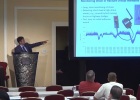How Wireless Monitoring Sensors Help Prevent Downtime in Data Centers
In today’s hyperconnected world, data centers are the beating heart of digital infrastructure. Maintaining their continuous operation is important for businesses relying on cloud computing, online services, and digital communications. Downtime in a data center can result in massive financial losses, reduced trust, and interrupted services. That’s why having a robust data center monitoring system is more important than ever.
Modern facilities are now turning to wireless data center monitoring sensors to detect early signs of failure and prevent costly outages. These technologies offer a more scalable, non-intrusive, and real-time approach to infrastructure health monitoring.

Why Data Center Monitoring is Essential
Downtime in a data center isn’t just an inconvenience, it’s a risk to critical operations. According to Uptime Institute, the average cost of a single data center outage can exceed $500,000. The causes can range from equipment failure and overheating to structural shifts or environmental anomalies like excessive humidity.
A comprehensive data center monitoring solution mitigates these risks by offering:
- 24/7 surveillance of environmental and structural conditions
- Real-time alerts to catch failures before they escalate
- Predictive insights that help with preventive maintenance
- Operational efficiency through intelligent data analytics
Wireless monitoring offers an even greater edge due to its minimal infrastructure disruption and low maintenance needs.

Wireless Sensors: The Backbone of Modern Data Center Monitoring Systems
At the core of modern data center infrastructure management lies a network of smart sensors. These wireless sensors can be deployed quickly across server rooms, cooling systems, and structural components.
Key Monitoring Parameters:
- Temperature: Prevent overheating and cooling inefficiencies.
- Humidity: Avoid condensation and corrosion.
- Vibration: Detect abnormal vibrations in HVAC units or other equipment.
- Tilt & Displacement: Monitor structural changes or shifts in raised flooring.
Together, they form an intelligent data center monitoring system that delivers accurate, real-time health insights.

Data Center Temperature Monitoring
Overheating is a major contributor to equipment failure. Excessive heat degrades server performance, shortens equipment life, and increases energy costs.
A robust data center temperature monitoring system provides:
- Spot measurements at rack, floor, and ceiling levels
- Trend analysis for heat distribution
- Alerts for temperature spikes or cooling failures
Wireless sensors can be easily mounted on racks, panels, or ceilings for full coverage without complex wiring.
Server Room Humidity Monitoring
Server room humidity monitoring is essential for preserving electronics. Both high and low humidity levels can be harmful:
- High humidity can lead to condensation, corrosion, and mould growth
- Low humidity increases the risk of static discharge, damaging sensitive electronics
Smart wireless sensors continuously measure relative humidity and send alerts when it crosses safe thresholds. These sensors help maintain optimal environmental conditions for longevity and reliability.
Server Room Temperature Sensors: Reliable and Scalable
Server room temperature sensors are no longer bound by wired limitations. Wireless technology enables fast deployment and scalability.
Advantages include:
- Battery-powered design with long operational life
- Real-time data transmission to the central dashboard
- Supports integration with facility systems for timely response
- Scalability from small server closets to enterprise-level data halls
Monitoring Structural Stability with Tilt and Vibration Sensors
Structural shifts or floor panel misalignments can compromise server safety. Wireless tilt sensors and accelerometers detect these minor displacements before they turn into major issues.
Benefits include:
- Non-intrusive installation on flooring or on walls
- Real-time alerts for displacement or unusual vibrations
- Trend reports for long-term analysis and decision making

Centralized Data Center Infrastructure Management (DCIM)
Wireless sensors feed into your data center infrastructure management platform, giving you centralized access to:
- Live environmental and structural data
- Historical trends to support predictive maintenance
- Custom thresholds and automated alerts
- Multi-location monitoring under one system
This unified approach simplifies asset management, reduces operational risk, and enables proactive decision-making.
Why Choose Wireless?
Wireless monitoring offers advantages over traditional wired systems:
- Easy installation, no cabling required
- Low maintenance and long battery life
- Real-time data via encrypted communication
- Instant alerts on threshold breaches
- Non-intrusive and does not interfere with operations
These features make wireless sensors the ideal solution for modern data center monitoring solutions.
Final Takeaway: Smart Monitoring Means Smarter Uptime
With rising digital demands and energy costs, data centers can’t afford to operate reactively. Investing in a data center monitoring system built around wireless sensors provides peace of mind, operational continuity, and long-term savings.
Whether it’s data center temperature monitoring, server room humidity monitoring, or tilt and vibration analysis, smart wireless sensors transform your facility from reactive to predictive maintenance.
Interested in Wireless Monitoring for Your Data Center? Explore SenSpot™ wireless sensors designed to optimize server environments and ensure reliability. Get in touch for a custom solution.


